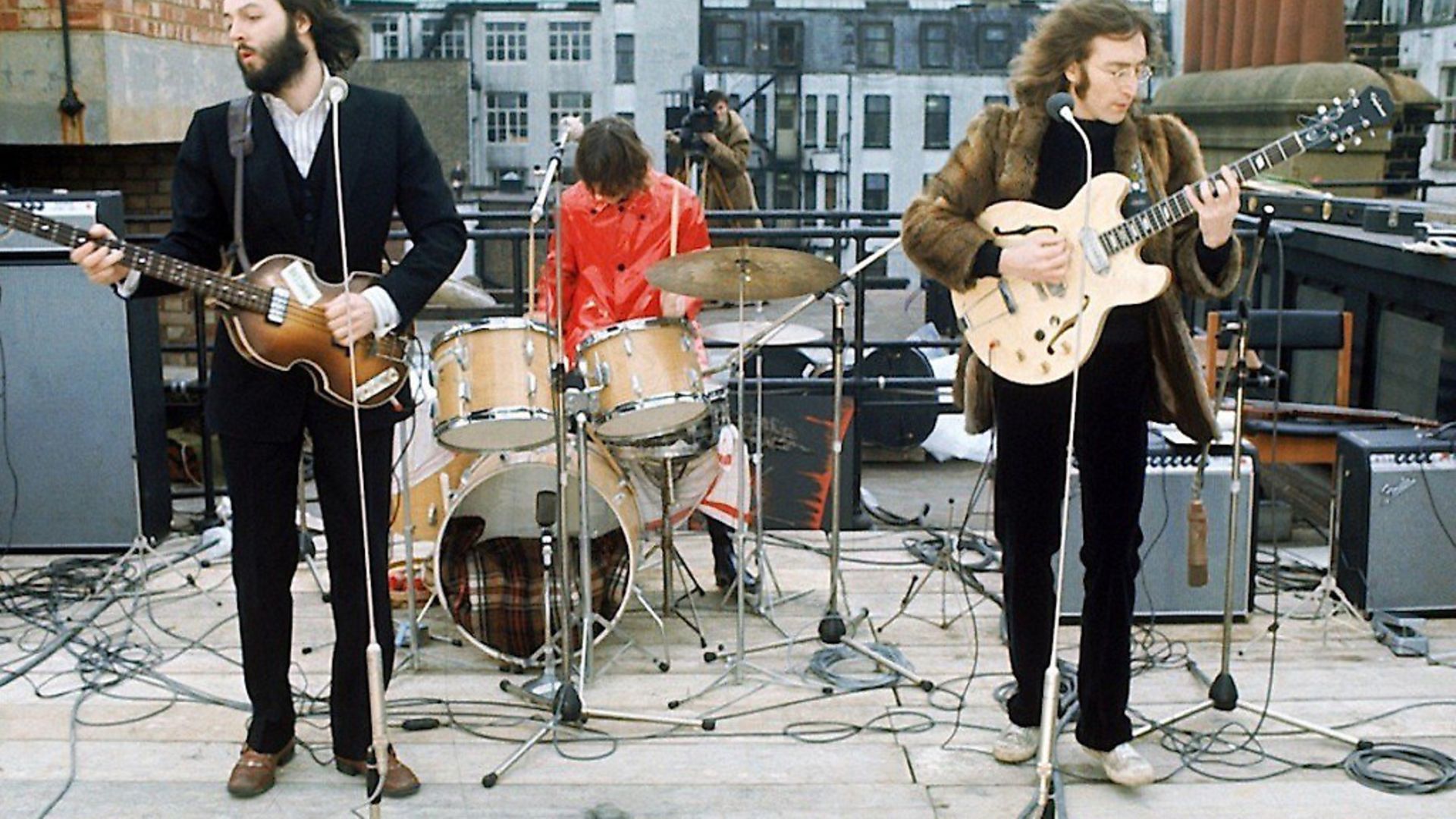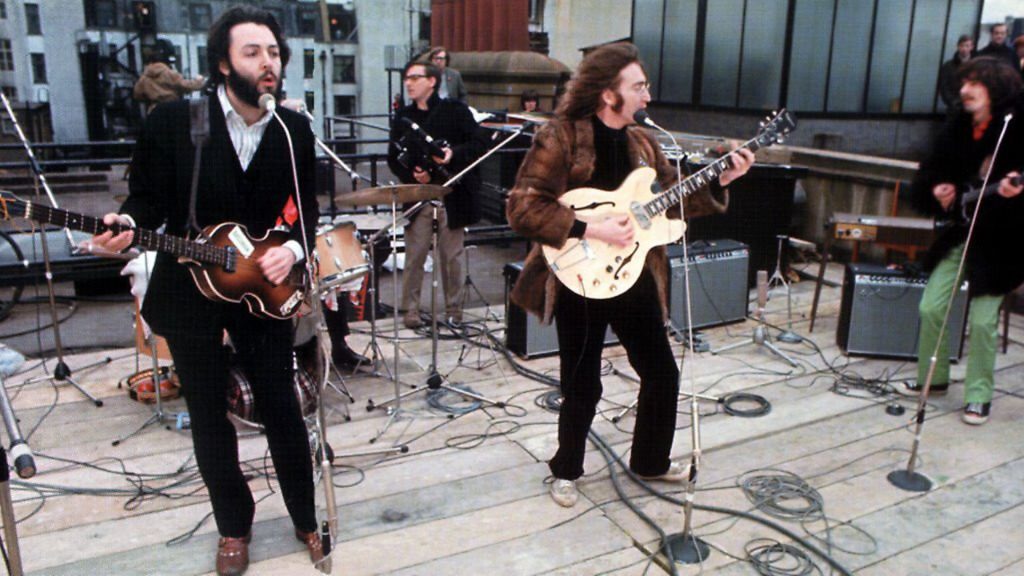
Fifty years ago this week saw one of the most memorable chapters in rock history. But, as RICHARD LUCK explains, not everything about the Fab Four’s last public act was quite as history remembers it.
It was on a cold grey Thursday afternoon that The Beatles and keyboardist Billy Preston made their way up to the roof of Apple Corps’ Savile Row headquarters and played four tracks for an audience of friends and Apple employees – plus a host of puzzled passers-by – before the police brought proceedings to a premature close.
As the feedback from their final song was lost on the wind, John Lennon lent back into his mic. ‘I’d like to say thank you on behalf of the group and ourselves,’ he quipped, ‘And I hope we passed the audition.’
The events of January 30, 1969, are as much a part of Beatles lore as the lunchtime gigs at The Cavern and the 12-hour shifts on Hamburg’s Reeperbahn. From The Rutles to The Simpsons, it is impossible to imagine a Beatles send-up without the rooftop farewell.
Yet as with so many things concerning John, Paul, George and Ringo, the gig itself wasn’t quite the momentous occasion history has chosen to remember it as. On the contrary, the Savile Row concert was a rushed, last-minute affair designed to bring the dire Let It Be experience to as rapid a close as possible.

Originally entitled Get Back, Let It Be was conceived as being both an album and a television special, one which documented the recording of said LP. So it was that in the first week of January 1969 – less than three months after finishing work on The White Album – the lads turned up at Twickenham Studios to allow their fans behind the curtain to see how The Beatles made the magic happen. The end result would suggest that, as with the creation of laws and sausages, the making of the Fab Four’s music was best left to the imagination.
Perhaps it was down to McCartney’s workaholism. Maybe it stemmed from the presence of Yoko Ono. Could the last stages of Lennon’s heroin addiction have been to blame? Whatever the issue, Let It Be was less a fiasco than a dark night of the soul.
Not helped by the fact that someone at Twickenham Studios apparently hadn’t paid the electricity bill, the sight of four friends falling out with one another in the bleakest of surroundings is heartbreaking when you consider how close a unit they’d once been.
While ceasing to work as a live act might have helped them on one front, The Beatles’ reinvention as a studio band had led to overfamiliarity. ‘I’ll play what you want me to play,’ a browbeaten Harrison tells a bumptious McCartney, ‘Or I won’t play at all if you don’t want me to. Whatever it is that’ll please you, I’ll do it.’ What eventually pleased George was quitting the band, which he did on January 10. For five days.
When Harrison returned to the fray, it was on condition that any notion of The Beatles going back on the road be nixed. In an effort to give the Let It Be documentary a focal point, the band had kicked around a few concert ideas with director Michael Lindsay-Hogg. A gig at the Pyramids, a concert in a Roman amphitheatre, a three-day residency at the Camden Roundhouse, a performance in an empty sports stadium – these and other ideas were conjured with before Harrison laid down the law.
As for who came up with the compromise of playing a few tracks on the roof of the Apple building, it’s hard to find anyone who hasn’t taken credit for it. Lennon, Starr, sound engineer Glyn Johns – it’s a textbook case of a successful idea having many fathers. The responsible party could also be accused of plagiarism, what with Jefferson Airplane having played on the roof of New York’s Schuyler Hotel the previous December.
With the open-air concert a go project, the group and Lindsay-Hogg had mere days to put the thing together. The chaos of the event extended to engineer Alan Parsons – later the butt of one of the better jokes in the first Austin Powers sequel – having to dash out on the morning of the gig to purchase pantyhose to wrap around the microphones in the hope of keeping wind noise to the minimum.
Add a stiff breeze to the standard chill of a January afternoon and it’s little wonder Starr and Lennon took to the roof wearing their wives’ coats. If the Liverpudlians were struggling with cold, Texan Billy Preston must have been wondering what he’d signed up for.
Brought on board at Harrison’s insistence, the affable keyboard player had helped to glue the band back together. His rewards for this service were lifelong friendships with the four, plus a credit on Get Back – the first and last time the band would acknowledge a fellow artist in this manner.
The Beatles’ Savile Row set spanned nine renditions of five songs. With Michael Lindsay-Hogg wanting to give himself as many choices as possible, the group cranked through Get Back twice before performing the first of two renditions of Don’t Let Me Down.
Before returning to the track, they sang three new numbers – I’ve Got a Feeling, One After 909 and Dig A Pony. There was then just enough time for a last stab at Get Back before the plugs were pulled. Forty-two minutes after it had begun, the end of the Beatles’ last concert was met with a quiet round of applause from a crowd probably smaller than the one John Lennon performed to at the Woolton fete where he first met Paul McCartney.
All good stories have villains and in this instance the roles are filled by the neighbours who complained about the noise and the police who brought the concert to a premature end. In truth, neither party deserves the criticism they’ve received. In the case of the police, they could have stopped the gig the moment the first complaint was received. With the local station just a few doors down from Apple, officers could have been up on the roof before the group were done with the first rendition of Get Back. In fact, the boys in blue were such good sports that, not only did they give the Beatles more playing time, they phoned ahead to give the band and their employees enough time to dispose of any exotic cigarettes they might have had upon their person.
As for the miffed neighbours, it’s not as if they knew that this would be the last time the band played together. More to the point, Apple had been the cause of countless headaches ever since it opened for business. Just weeks earlier, the office had been taken over by a chapter of Hells Angels who brought a surliness and air of menace to Savile Row the likes of which the street had never experienced. Far from upbraiding them for complaining about the noise, it’s a miracle they hadn’t sought to have the boys evicted.
The aftermath of the Apple set was as unhappy as it is infamous. Although the harmony Preston helped nurture enabled the band to record a final landmark album, the glory of Abbey Road – released on September 16, 1969 – was tarnished by the whole Get Back/Let It Be debacle. Despite being predominantly recorded ahead of Abbey Road, the group’s ‘last’ LP finally limped into record shops on May 8, 1970, almost a month after McCartney had called time on The Beatles.
To add insult to injury, Phil Spector had been given carte blanche to mix Let It Be however he saw fit. McCartney’s dissatisfaction with Spector’s handiwork has never abated, with Paul walking out of the 1997 Q awards when the magazine deigned to present the producer with a lifetime achievement award.
With all the infighting and acrimony that followed, it’s romantic to think that the Beatles’ rooftop gig represented the real end of their time together. There’s certainly a lot more to like about the sight of the boys in full swing than all those pictures of McCartney and Lennon emerging from meetings surrounded by lawyers, managers and the world’s press.
Where once there had been lovable Mop Tops now stood four hirsute chaps who looked for all the world like they’d just got back from ‘Nam. But while Lennon might have been using cue cards and Harrison was clearly freezing, there’s one thing about their last hurrah that’s undeniable – they all seemed to be enjoying themselves. From McCartney dancing with his bass to Lennon laughing his way through his losing battle with the wind, for a minute we are reminded of what had been and what could never be again.
They mightn’t have been the first to do it, and they certainly weren’t the last – U2 having taken to the roof a number of times without ever doing the decent thing – but The Beatles: Live At 3 Savile Row remains the ultimate rooftop concert, the test of time having been passed as emphatically as the audition.









